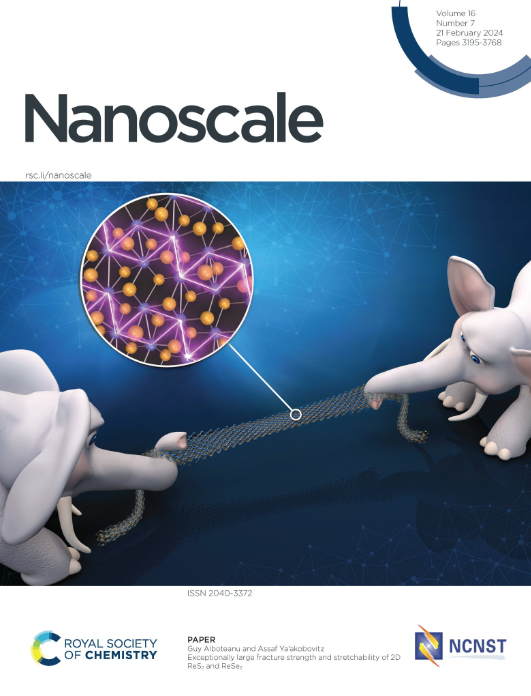三价离子交换的磁硬石:结构和结构的改变伴随着自发纳米颗粒的形成
IF 5.1
3区 材料科学
Q1 CHEMISTRY, MULTIDISCIPLINARY
引用次数: 0
摘要
尽管对金属阳离子络合反应的认识有限,但人们对镁辉石与金属阳离子的离子交换和吸附机理进行了广泛的研究。本研究成功地描述了三价金属阳离子(M3+= Fe, In, Al)对Na+-magadiite可能的不同吸附反应以及结构和结构行为。Na+与M3+的离子交换反应导致层状结构恶化,最终形成h型,表明随后吸附M3+发生了附加反应。层间结构的变形、热稳定性以及层间微孔的形成导致表面积的增加,证明了M3+在层间的进一步结构变化和成功接枝。所有M3+-磁长岩均表现出均匀的球形纳米颗粒,其大小和数量随溶液中M3+的类型和浓度而变化。本研究初步全面解释了M³+ (Fe³+、In³+、Al³+)与镁铁石的离子交换和络合行为,详细描述了由此产生的结构扭曲、纳米颗粒形成和层间接枝,具有催化和环境应用意义。镁辉石中的三价离子交换比二价离子交换导致更广泛的结构修饰,其特征是框架破坏、h型生成和M³+接枝。这些独特的效果突出了三价离子交换磁石的增强可调性,强调了它们在吸附、分离和催化方面的先进应用潜力。这些与M3+离子交换反应后镁辉石结构和结构性质的显著变化为纳米材料的制备提供了新的见解,这些纳米材料可用于催化、环境修复等相关领域。本文章由计算机程序翻译,如有差异,请以英文原文为准。
Trivalent Ion-exchanged Magadiite: Structural and textural modifications accompanied with spontaneous nanoparticle formation
Ion-exchange and adsorption mechanism of magadiite with metal cations have been widely investigated despite the limited knowledge of their complexation reactions. This study has successfully described the possible distinct adsorption reactions along with the structural and textural behaviors of Na+-magadiite with trivalent metal cations (M3+= Fe, In, Al). Ion-exchange reaction of Na+ with M3+ led to deterioration of layered structure and eventually to H-form, suggesting subsequent additional reactions of adsorbed M3+. Further structural changes and successful grafting of M3+ in the interlayers were evidenced by the distortion of layered structure, thermal stability, and formation of interlayer micropores resulting to increased surface areas. All M3+-magadiites exhibited uniform spherical-shaped nanoparticles of which size and population varied depending on the type and concentrations of M3+ in the solution. This study provides the initial comprehensive explanation of the ion exchange and complexation behavior of M³⁺ (Fe³⁺, In³⁺, Al³⁺) with magadiite, detailing the resulting structural distortions, nanoparticle formation, and interlayer grafting, with implications for catalytic and environmental applications. Trivalent ion exchange in magadiite results in more extensive structural modifications than divalent exchange, characterized by framework disruption, H-form generation, and M³⁺ grafting. These unique effects highlight the enhanced tunability of trivalent ion-exchanged magadiites, underscoring their potential for advanced applications in adsorption, separation, and catalysis. These remarkable changes in the structural and textural properties of magadiite upon ion-exchange reaction with M3+ contribute new insights on nanomaterial fabrication applicable for catalysis, environmental remediation, and related fields.
求助全文
通过发布文献求助,成功后即可免费获取论文全文。
去求助
来源期刊

Nanoscale
CHEMISTRY, MULTIDISCIPLINARY-NANOSCIENCE & NANOTECHNOLOGY
CiteScore
12.10
自引率
3.00%
发文量
1628
审稿时长
1.6 months
期刊介绍:
Nanoscale is a high-impact international journal, publishing high-quality research across nanoscience and nanotechnology. Nanoscale publishes a full mix of research articles on experimental and theoretical work, including reviews, communications, and full papers.Highly interdisciplinary, this journal appeals to scientists, researchers and professionals interested in nanoscience and nanotechnology, quantum materials and quantum technology, including the areas of physics, chemistry, biology, medicine, materials, energy/environment, information technology, detection science, healthcare and drug discovery, and electronics.
 求助内容:
求助内容: 应助结果提醒方式:
应助结果提醒方式:


